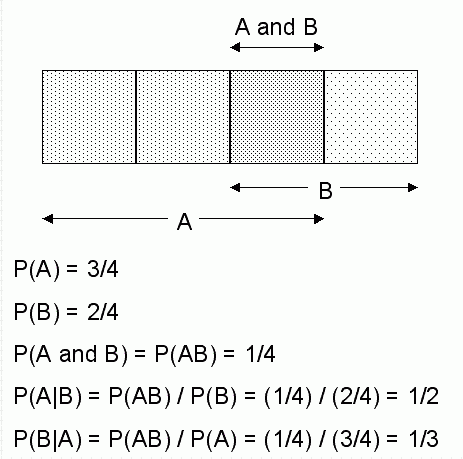About Naive Bayes
Naive Bayes algorithm is based on conditional probabilities. It uses Bayes' theorem, a formula that calculates a probability by counting the frequency of values and combinations of values in the historical data.
Bayes' theorem finds the probability of an event occurring given the probability of another event that has already occurred. If B represents the dependent event and A represents the prior event, Bayes' theorem can be stated as follows.
Note:
Prob(B given A) = Prob(A and B)/Prob(A)
To calculate the probability of B given A, the algorithm counts the number of cases where A and B occur together and divides it by the number of cases where A occurs alone.
Example 7-4 Use Bayes' Theorem to Predict an Increase in Spending
Suppose you want to determine the likelihood that a customer under 21 increases spending. In this case, the prior condition (A) is "under 21," and the dependent condition (B) is "increase spending."
If there are 100 customers in the training data and 25 of them are customers under 21 who have increased spending, then:
Prob(A and B) = 25%
If 75 of the 100 customers are under 21, then:
Prob(A) = 75%
Bayes' theorem predicts that 33% of customers under 21 are likely to increase spending (25/75).
The cases where both conditions occur together are referred to as pairwise. In Example 7-4, 25% of all cases are pairwise.
The cases where only the prior event occurs are referred to as singleton. In Example 7-4, 75% of all cases are singleton.
A visual representation of the conditional relationships used in Bayes' theorem is shown in the following figure.
Figure 7-11 Conditional Probabilities in Bayes' Theorem

Description of "Figure 7-11 Conditional Probabilities in Bayes' Theorem"
For purposes of illustration, Example 7-4 and Figure 7-11 show a dependent event based on a single independent event. In reality, the Naive Bayes algorithm must usually take many independent events into account. In Example 7-4, factors such as income, education, gender, and store location might be considered in addition to age.
Naive Bayes makes the assumption that each predictor is conditionally independent of the others. For a given target value, the distribution of each predictor is independent of the other predictors. In practice, this assumption of independence, even when violated, does not degrade the model's predictive accuracy significantly, and makes the difference between a fast, computationally feasible algorithm and an intractable one.
Sometimes the distribution of a given predictor is clearly not representative of the larger population. For example, there might be only a few customers under 21 in the training data, but in fact there are many customers in this age group in the wider customer base. To compensate for this, you can specify prior probabilities when training the model.
Related Topics